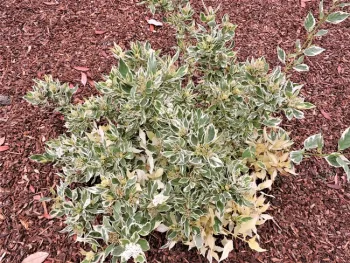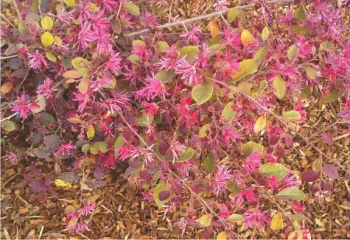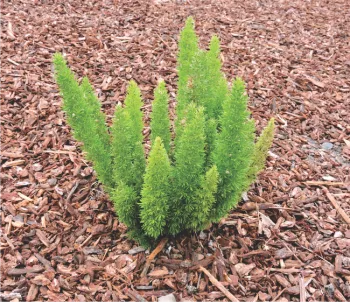by Susan Duquette

Yellow Twig Dogwood Silver and Gold Cornus sericea
The Yellow Twig Silver and Gold Dogwood is grown for its variegated foliage and its yellow twigs in winter, offering you year round beauty in your yard. It is lush and full and attracts butterflies and birds. It prefers to be moist, but not too wet or too dry. It spreads by root suckers to form a thicket of stems. It is often planted in multiples to form a hedge.
This North American native plant is hardy in zones 3-9 and likes full sun to part shade. It grows up to 5-7' high by 6-8' wide. It is a deciduous bush and blooms May through June with delicate creamy white flowers which later form bluish-tinged white berries that song birds find especially tasty. The leaves drop in winter and expose its beautiful yellow twigs.
Pruning should be done in late fall after the plant has shed all its leaves and is dormant. Prune branches at the base above the first node. Remove any old, dead or diseased twigs. The best color is on newer growth. Every 2-3 years you may choose to do hard pruning by cutting all stems to renew the bush. I find that just doing the pruning of old wood has kept me from doing a hard prune.
This dogwood is easy to propagate. It can be rooted in water or well-drained soil. Try cutting stems 6 to 8” long and insert the twigs in a pot or vase. There is no need to use a root hormone.

The red Loropetalum Chinese fringe flower is native to Japan, China and the Himalayas. It is a very hardy plant known for its longevity. The main use of this plant is as a foundation plant. It grows 3-6' high by 7-10' tall. It is an evergreen with dark green and purple leaves and it blooms March through June producing its lovely red fringe flowers. The loropetalum likes full to part sun, is drought tolerant once established and fast growing. It is a very popular plant in the residential gardens of Napa.
When planting, dig a hole 2-3 times the size of the rootball. After you've planted it add some natural fertilizer. Prune after the first flowering in late spring. It is best to only prune 20% of the plant at a time. Prune by making cuts just above a leaf node. You can shape your plant by cutting different lengths. If there are dead branches, cut them at their origin. Thinning cuts promote growth.
The loropetalum is easy to propagate. You can do it by putting them in soil or rooting in water. Cut stems 6-9” long and put in a pot with well-drained soil and keep moist. It takes 5-6 weeks for them to root.

The Meyeri Fern is not a true fern as they propagate by seed and do not produce spores. The name most likely originated from the fact that they have clumping habits akin to ferns. The Meyeri has outward sprawling fibrous roots. They are a very hearty specimen plant for zones 9-11 and flourish with little care. They like part shade to part sun. If they are planted in the full sun, they become more compact and dense. When established they are drought resistant and quite pest resistant. They grow up to 2' tall by 2' wide and bloom in late winter to early spring.
They are an evergreen offering green foliage year-round, first blooming with white flowers that then form red berries holding the seed pods. The birds enjoy these berries and will take the seeds and distribute them in different areas. They are often seen in local landscapes and are also used in creative flower arrangements.
Spring is the best time for pruning and shaping. Pinch back stem tips as needed to maintain the plant form. Cut back yellowed or dead stems at soil level. Every two to three years you can do a hard pruning to rejuvenate growth. Cut back to 2-3” above soil. This is also a great time to divide the plant in half or quarters.
Dig up the root ball and you will notice that there are tubers and fleshy roots. Look for a spot where you can divide, loosen and move roots out of the way to cut. It is much safer for the plant if you use a stick to enter the root ball and go slow in order not to destroy the roots. Transplant the sections into a pot with moist, acidic soil and place in light shade. There will be new growth in 1-2 months.
Once established, these three plants require little water and maintenance. In addition, these plants can be counted on to demonstrate some visual interest alternating throughout the year.
The UC Master Gardeners and the City of Napa have joined in a partnership at the Las Flores Community Center where instructional events are planned for the last Saturday of the month through 2022. Topics will center on research-based horticultural and climate change issues by featuring water saving plants and soil care.
Next week, in the last installment of these articles, we will talk about the glossy abelia, manzanita & carpet roses
Napa Master Gardeners are available to answer garden questions by email: mastergardeners@countyofnapa.org. or phone at 707-253-4143. Volunteers will get back to you after they research answers to your questions.
Visit our website: napamg.ucanr.edu to find answers to all of your horticultural questions.
Photo credits: Olga Morham
Informational links:
Yellow twig dogwood https://www.monrovia.com/yellow-twig-dogwood.html
Loropetalum https://plants.ces.ncsu.edu/plants/loropetalum-chinense-f-rubrum/
Meyeri Fern https://ucanr.edu/blogs/blogcore/postdetail.cfm?postnum=27594

